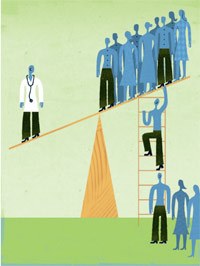The New Doctor/Patient Relationship
It’s one doctor and many patients — all at once:
 Shared medical appointments are becoming more widespread as physicians look for more efficient and effective ways to treat increasing numbers of patients with chronic diseases. The visits could increase significantly under the nation’s healthcare overhaul when millions more Americans gain insurance coverage and need to access doctors. Multi-patient appointments are especially valuable in areas with physician shortages, proponents say. Proponents say the model allows patients to get appointments faster and spend more time with doctors.
Shared medical appointments are becoming more widespread as physicians look for more efficient and effective ways to treat increasing numbers of patients with chronic diseases. The visits could increase significantly under the nation’s healthcare overhaul when millions more Americans gain insurance coverage and need to access doctors. Multi-patient appointments are especially valuable in areas with physician shortages, proponents say. Proponents say the model allows patients to get appointments faster and spend more time with doctors.


Well this is just music to my ears… I can’t wait to hear about all of my neighbors problems. Much less talk about my “confidential” issues with others in the room.
How about switching to a virtual setting?
You know, a virtual conference with my doctor would be nice.
I probably spend over 2 hours going to the doctor.
30 minutes driving roundtrip
1 hour waiting in the waiting room
30 minutes waiting in the actual room
10 minutes talking to the doctor
I’ve seriously contemplated sending them a bill for the hours I’ve spent waiting…
But really, video conferencing seems like a great way to have simple check ups with the doc.
If this group setting will decrease my wait time at the doctor, I’ll put up with it.
Questionable… I think my privacy is worth more than a lengthy wait.
as long as their are options, you’ll both get what you want.
Or doctors could begin to stick to their appointment times
You know it’s hardly ever the doctor that causes appointments to run late. Trust me-I work for a doctor-he HATES it when he runs behind. But when a patient comes in and requires a certain level of care, he has to provide it. Patients get way too talkative and then decide, oh, can you look at this too! Doctors try to give each patient the same level of care-but you can never predict what might pop up. If patients would be more descriptive when scheduling their appointment-things would flow much better! Don’t call and tell us you have a little nail fungus and then come in and want your previous broken ankle looked at!
Maybe the nurse in the OB/GYN office can arrange the gynecological exam tables like wagon wheel spokes surrounding a hum. The doctor could merely spin around the awaiting line of women (on tables, with legs in stirrups) without having to do much more than rotate to see the next patient. He could recite the same speech for all to hear so maybe some female patients could learn the answer to their questions without having to ask. Sounds efficient to me.
What’s next? Hospitals should also bring back the hospital ward. This pesky notion of personalized medicine it highly inefficient.
If a group of women wanted to save costs by doing that, and doctor agreed, then why not?
Maybe if doctors were paid on a different measure, we wouldn’t have this problem.
Interesting > http://healthblog.ncpathinktank.org/doctors-get-paid-more-for-doing-than-thinking/
I like this as an option for people trying to save money. It increases access for people who would have otherwise had none.
The problem is when government policies are pinching us so that we HAVE to do things that we wouldn’t have done before, like in this case.
The government takes and the free-market finds new inventive ways to help people.
At this rate, the free-market will lose the war to stifling government policy
I can see families doing this, but I can’t imagine going on a group doctor visit with strangers.
Doctors are now being encouraged to treat populations instead of individuals. I’m not sure I like this propostion.
You and me both, Perry
If you think about it, the current system of physician care is a very inefficient system. Care is legally restricted to a licensed physician who trained for 12 years after high school. They are expected to allocate 12 to 30 minutes for each patient — most of whom are reimbursed by insurers, health plans or government as rates that are low. Doctors cannot easily innovate. I can see how some forms of group therapy could be valuable.